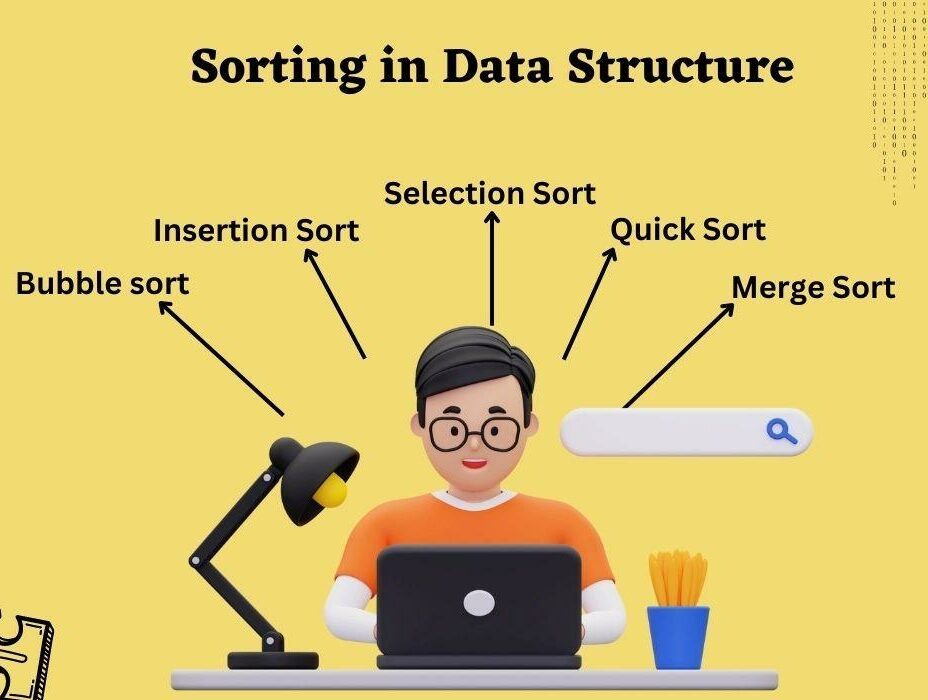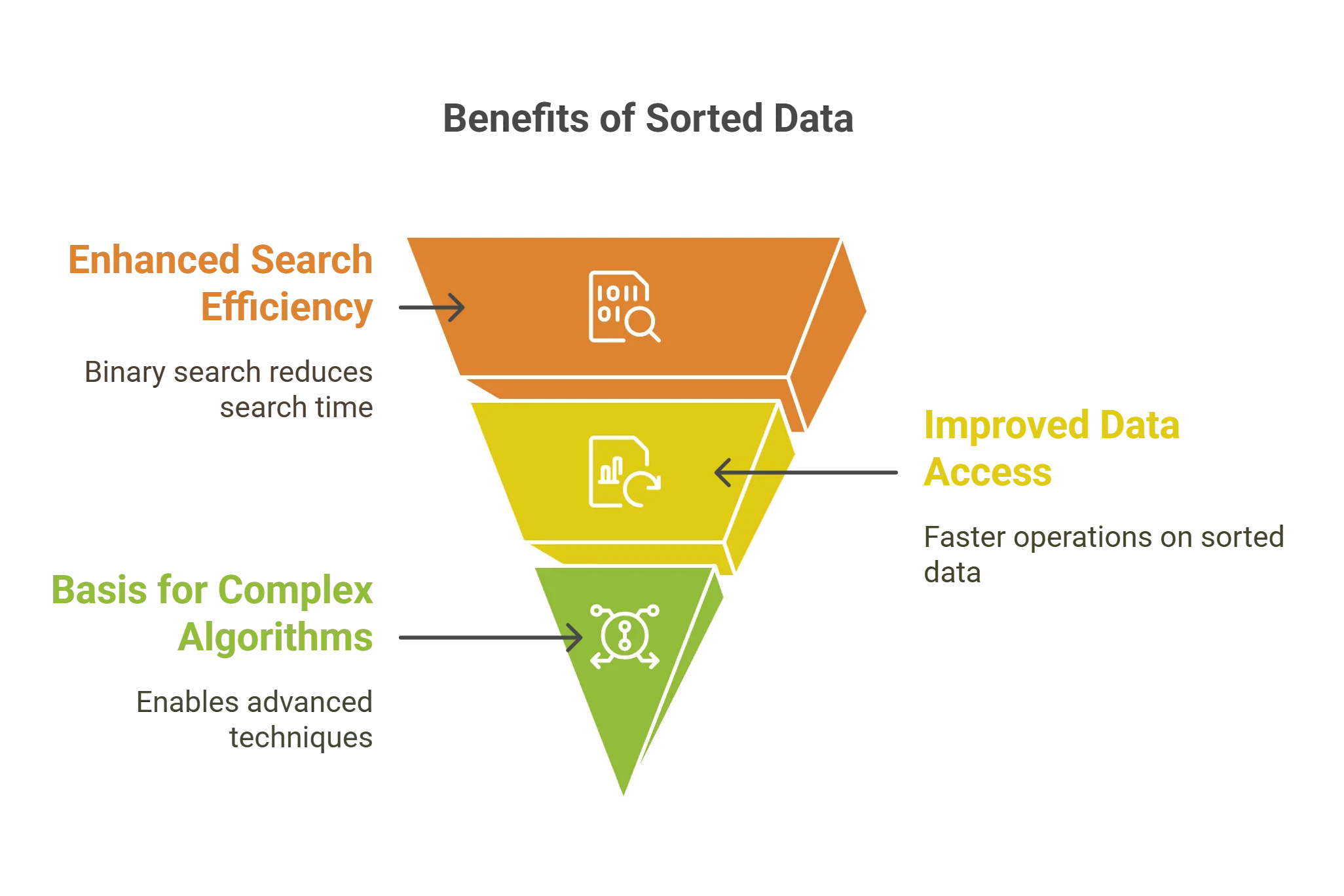Sorting in Data Structures: Different Types and Examples
Table of Contents

Let’s start with something we’ve all experienced: finding a document in a messy folder.
You’re scrolling, scanning, clicking, trying to make sense of the chaos. But all you get is more confusion and a wall of clutter.
But once that same folder is neatly organized by date, category, or priority, the job takes just a few seconds, right?
That’s exactly what sorting in data structure does! How? Read on and discover it yourself!
Introduction to Sorting in Data Structures
Whether you’re building a stock market dashboard, training an AI model, or simply managing millions of customer records, sorted data equals smart data. It’s faster, cleaner, more efficient and absolutely essential.
In fact, sorting is one of the first and most fundamental concepts in computer science, yet also one of the most misunderstood or oversimplified.
So if you’re a professional looking to upskill or stay ahead in your tech career, mastering sorting in data structures can give that competitive edge you are looking forward to.
What is Sorting in Data Structures?

*naukri.com
By definition, sorting in data structures is the process of arranging data elements in a particular order, most commonly ascending or descending.
But what’s more to it?
Sorting is basically the powerhouse behind everything from:
- Google search results (ranked in milliseconds)
- E-commerce filters (price low to high)
- Stock tickers (highest gains)
- Chat applications (recent messages)
- To even machine learning pre-processing
And now, with the explosion of Big Data and real-time computing, choosing the right sorting method in data structure can change system performance even more drastically.
Why Does Sorting in Data Structure Even Matter?
Let’s connect this to your day job or your dream job.
Imagine you’re a backend developer managing a product inventory API. Users want the ability to sort items by:
- Price
- Ratings
- Latest arrivals
If your sorting logic isn’t optimized, guess what?
Your response time suffers, your UX drops, and your customers bounce.
Same story in:
- Cybersecurity → logs sorted by threat level
- Finance → transactions sorted by timestamp
- Healthcare → patient records sorted by urgency
So the point here is, sorting in data structure isn’t just limited to the IT industry, it’s required in various fields and can be highly helpful for every professional solving real-world problems with data.
The Core Idea: Why Structure Matters in Sorting
Without structure, data is chaos.
In fact, most advanced algorithms from search to scheduling only perform well when the data is pre-sorted. How?
Well, sorting organizes your data into a structure that:
- Reduces complexity
- Speeds up processing
- Prepares it for algorithms to work efficiently.
How Does Sorting in Data Structures Actually Work?

*upgrad.com
Great question. Let’s warm up before we dive deeper.
Here’s a visual to frame it better:
Imagine This List:
[5, 2, 9, 1, 6]
We want to sort it in ascending manner.
Depending on which technique we use, we could:
- Swap adjacent elements until the list bubbles into order (Bubble Sort)
- Pick each element and insert it where it fits (Insertion Sort)
- Build a tree and extract the max repeatedly (Algorithm for Heap Sort)
- Divide and conquer using pivots (Quick Sort)
- Recursively merge sorted halves (Merge Sort)
Each method belongs to a broader category of sorting methods in data structures, with its own advantages and performance metrics.
To put it all in short: Different sorting problems need different algorithms. And the more you understand them, the smarter your solutions get.
Key Concepts You’ll Encounter
Before we move into the deeper waters, here are a few terms and ideas you’ll want to keep in mind (and yes, you’ll see them throughout the blog):
| Concept | What It Means |
| Time Complexity | How long the sorting takes, e.g., O(n²), O(n log n) |
| Space Complexity | How much memory it uses |
| Stability | Whether elements with equal keys retain their order |
| Recursion | Whether the algorithm breaks itself into smaller tasks |
| In-Place Sorting | Whether it needs extra space to sort |
Don’t worry, we’ll explain each with real examples.
Why Professionals Must Master Sorting in Data Structures
If you’re serious about upskilling in data science, software development, systems design, or even product roles that touch tech, you need to:
- Understand different types of sorting in data structures
- Know how and when to use each sorting method
- Write clean, optimized sorting logic
Overall, whether you’re solving LeetCode challenges, leading a dev team, or interviewing, sorting in data structure shows up everywhere.
And here’s something even more interesting:
You’ll never just be asked to implement Bubble Sort.
You’ll be asked why you used it.
Or how you’d optimize it.
Or what would happen at scale.
That’s where deep insight, not just syntax, makes you stand out in the crowd.
Additional Sorting Terms You Should Know
As we go deeper, we’ll explore and repeat key sorting types like:
- The bubble sort data structure (great for visual learners)
- The insertion sort data structure (ideal for nearly-sorted data)
- The algorithm for heap sort (memory-efficient and fast)
- Broader types of sorting in data structures
- Alternative sorting methods in data structures used in modern systems
A Quick Q&A to Know Your Sorting in Data Structures Knowledge
Let’s end this section with a tiny challenge:
- You have a dataset of 10 million user records.
- You need to sort them by last login time.
- But your server has limited memory.
Which algorithm do you choose and why?
Don’t worry, we’ll help you answer this by the end of the next section.
The Different Types of Sorting in Data Structures
If the above sections got you thinking about why sorting in data structure matters, this section is where we break down the how, with code logic, best-fit scenarios, and real-world relevance.
You will learn the types of sorting in data structures you’re most likely to encounter in interviews, systems, and advanced coding environments.
1. Bubble Sort: The Simplest Sorting in Data Structure
If sorting algorithms had a family tree, bubble sort would be the well-meaning but slightly slow grandparent. Still valuable, still worth knowing, but often outpaced in performance.
How it Works
Bubble sort repeatedly steps through the list, compares adjacent elements, and swaps them if they’re in the wrong order. This is done again and again until the list is fully sorted.
Example:
Given [5, 1, 4, 2, 8], bubble sort compares:
- 5 and 1 → swap
- 5 and 4 → swap
- 5 and 2 → swap
- 5 and 8 → no swap
After the first pass, 8 is in the correct place. The next pass does the same for the remaining elements.
Code Snippet (Pseudocode)
for i from 0 to n-1:
for j from 0 to n-i-1:
if arr[j] > arr[j+1]:
swap(arr[j], arr[j+1])
When to Use It
- Small datasets
- Learning algorithm fundamentals
- Visualizing sorting logic
Performance
- Time Complexity: O(n²)
- Space Complexity: O(1)
- Stable: Yes
2. Insertion Sort: When the List is Nearly Sorted
The insertion sort data structure is similar to sorting playing cards in your hand. You pick one card at a time and place it in the appropriate location.
How it Works
It builds the final sorted array one item at a time. It compares each new element to those that came before it and places it in the right place.
Example:
Start with [4, 3, 2, 10]
- 3 is compared with 4 → insert before
- 2 is compared with 3 and 4 → insert before both
- 10 stays at the end
Code Snippet (Pseudocode)
for i from 1 to n:
key = arr[i]
j = i – 1
while j >= 0 and arr[j] > key:
arr[j+1] = arr[j]
j -= 1
arr[j+1] = key
When to Use It
- Nearly sorted data
- Small data sets
- Data streams where insertion is frequent
Performance
- Time Complexity: O(n²) worst, O(n) best
- Space Complexity: O(1)
- Stable: Yes
3. Heap Sort: Speed and Memory Balance
The heap sort technique is based on a binary heap data structure, such as a max heap. It repeatedly removes the largest piece and rebuilds the heap until it is sorted.
How it Works
- Convert the list into a max heap
- Swap the first and last element
- Reduce heap size and re-heapify
- Repeat
Example (Steps Simplified):
Original: [4, 10, 3, 5, 1]
Heapified: [10, 5, 3, 4, 1]
Sorted: [1, 3, 4, 5, 10]
Code Snippet (Pseudocode)
buildMaxHeap(arr)
for i from n-1 to 1:
swap(arr[0], arr[i])
heapify(arr, 0, i)
When to Use It
- When memory usage is critical
- Sorting large files or datasets
- Priority queues and scheduling systems
Performance
- Time Complexity: O(n log n)
- Space Complexity: O(1)
- Stable: No
4. Merge Sort: Divide and Conquer
Merge sort is one of the quickest sorting algorithms in data structures for huge, unsorted lists. It employs recursion to break down the list and then merges it back together in sorted order.
How it Works
- Divide the list into halves recursively
- Sort each half
- Merge them back in order
Example:
[38, 27, 43, 3, 9]
Split → [38, 27], [43, 3, 9]
Recursive sort and merge → [3, 9, 27, 38, 43]
When to Use It
- Sorting linked lists
- External sorting (files too large to fit in memory)
- Parallel processing
Performance
- Time Complexity: O(n log n)
- Space Complexity: O(n)
- Stable: Yes
5. Quick Sort: The Industry Favorite (But With Caution)
Quick sort is used in most language libraries (such as Python’s sorted() function) because of its rapid performance and in-place sorting capabilities.
How it Works
- Choose a pivot
- Partition the list into two sublists:
- Items less than pivot
- Items greater than pivot
- Items less than pivot
- Recursively apply quick sort to sublists
Example:
List: [7, 2, 1, 6, 8, 5, 3, 4]
Pivot: 4
Partitions: [2, 1, 3] and [7, 6, 8, 5]
Sorted: [1, 2, 3, 4, 5, 6, 7, 8]
When to Use It
- Performance-critical systems
- In-memory sorting
- General-purpose use
Performance
- Time Complexity: O(n log n) average, O(n²) worst
- Space Complexity: O(log n)
- Stable: No
Comparison Table: Sorting Methods in Data Structure
| Sorting Method | Time Complexity | Space | Stable | Best For |
|---|---|---|---|---|
| Bubble Sort | O(n²) | O(1) | Yes | Teaching basics |
| Insertion Sort | O(n²) | O(1) | Yes | Nearly sorted data |
| Heap Sort | O(n log n) | O(1) | No | Memory-constrained systems |
| Merge Sort | O(n log n) | O(n) | Yes | External/linked lists |
| Quick Sort | O(n log n) | O(log n) | No | In-memory, general cases |
This breakdown gives you a practical lens on each type of sorting in data structures with its real-world applicability.
How to Choose the Right Sorting Algorithm?
Think of sorting as a toolkit. You wouldn’t use a hammer to drive a screw. Similarly, you should not use bubble sort on a million records.
Ask yourself:
- How large is the dataset?
- Is it already partially sorted?
- Is memory a concern?
- Do I need the sort to be stable?
There’s no one-size-fits-all, and that’s the beauty (and power) of knowing multiple sorting methods in data structures.
Real-World Applications of Sorting in Data Structures and Career Impact
You’ve now decoded the concept of sorting in data structures and explored the many types, logic, and strategies. So, let’s take a further look at where all of this actually shows itself in the workplace.
Sorting in System Design: Where It Actually Matters
Here’s how sorting in data structures quietly powers major tech stacks you use daily:
a) E-commerce Platforms
- Product Listings: Sorted by price, popularity, discount, ratings
- Inventory Management: Sorted by stock status, sales velocity, or SKU
Ever searched “running shoes under ₹2000”? Sorting made that possible in milliseconds.
b) Financial Applications
- Stock Market Dashboards: Sorted by price change, volume, or volatility
- Transaction Logs: Chronologically sorted for auditing or fraud detection
c) Social Media & Messaging Apps
- Feed Algorithms: Content sorted by engagement, recency, or relevance
- Notifications & Messages: Sorted by timestamp or priority
d) Healthcare & Public Systems
- Patient Records: Sorted by risk level, appointment date, or diagnosis severity
- Test Results: Organized by date or abnormality
And in every case, choosing the right sorting method in data structure influences speed, accuracy, memory load, and user experience.
How Sorting Shapes Your Career in Tech
Here’s how sorting is a gateway to bigger things:
If you’re a developer…
Knowing when to use merge sort over heap sort in a production API could make you the architect who saves milliseconds on millions of calls, translating to saved bandwidth, happier users, and cost efficiency.
If you’re in data science…
Your preprocessing step might involve cleaning and sorting massive data frames. Want efficient training loops and clean model outputs? Sorting matters here too.
If you’re preparing for interviews…
FAANG-style coding rounds regularly test your mastery of sorting under constraints:
- Can you write an in-place quicksort?
- How would you sort a stream of data that never stops?
- Which sorting method is best for 100 GB files on disk?
Sorting in data structure is the bedrock of algorithmic thinking, and your understanding of it signals technical depth, precision, and critical decision-making.
How Jaro Education Helps You Go Beyond Surface-Level Learning
At Jaro Education, we believe upskilling isn’t about memorizing syntax—it’s about understanding systems. Our programs are built for working professionals like you who want to:
- Deepen algorithmic foundation
- Learn by doing through case-based assignments
- Apply sorting in real-world scenarios like scalable backend design, AI data pipelines, and enterprise architecture
Because you’re not just learning to sort a list—you’re preparing to sort through complexity, at scale, in your own career.
Whether you’re transitioning to a tech-first role, moving into data science, or preparing for system design interviews, mastering sorting in data structure is your competitive edge.
Visit our website to learn more about how Jaro Education can help you learn smart, build fast, and lead with confidence.
Final Thoughts
Sorting in data structures is ultimately about order, and in business, the order of information affects decision-making:
- Sorted dashboards = faster insights
- Sorted customer data = better personalization
- Sorted logs = faster debugging
So, in a world obsessed with real-time response, sorting empowers speed, clarity, and control.
And as a professional aiming to upskill? Sorting in data structures makes you a problem solver who understands how machines think.
Frequently Asked Questions
Why does sorting matter so much in the real world?
Well, imagine sifting through unsorted data every time you need something—slow, right? Sorting just makes everything faster and easier to handle, whether it’s a search result or a server log.
Any go-to sorting method when you're dealing with massive amounts of data?
Yeah—merge sort or heap sort usually hold up well under pressure. Quick sort’s great too, but if the data’s messy, one bad pivot can slow everything down.
Is bubble sort used in real applications?
Well, generally it’s not, as it’s simple and useful for beginners to understand how sorting works. But it’s too slow for real systems.
What does ‘stable sorting algorithm’ mean? And what is its importance?
Say you’re sorting employees by department and then by name. A stable sort keeps the original order when values match—which is pretty important in layered sorting like that.
What’s one sorting challenge people don’t usually think about?
Sorting data that never ends—like real-time feeds from sensors or stock tickers. You can’t just wait for it all to come in, so you’ve got to sort as you go, without blowing up your memory.







![Journalism-and-Mass-Communication-Salary-in-India-in-2025-[Average-to-Highest]](https://jaro-website.s3.ap-south-1.amazonaws.com/2025/10/Journalism-and-Mass-Communication-Salary-in-India-in-2025-Average-to-Highest-1024x576.webp)










